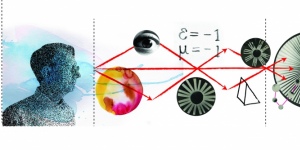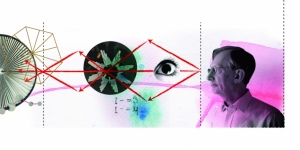A profile of Professor John Pendry, pioneer of metamaterials
by Kerry Noble

Theoretical physicist John Pendry reveals what gets him thinking and the inspirations behind his new ideas.
By Anjana Ahuja
I have just disembarked at a train station outside London, when I spot the tall, thin, bespectacled man in a woollen jumper smiling at me from the opposite platform. We shake hands and climb into his polished black Lexus, me anxiously trying not to muddy the plush cream mats while the driver, one of the world’s leading theoretical physicists, chats about property prices in this well-heeled part of the world.
Professor Sir John Pendry speeds me to an immaculately kept bungalow; the sitting room and study are decorated not with equations but with framed photographs that he himself has taken, courtesy of the digital camera that he carries everywhere in his briefcase. The scenes – Isles of Scilly landscapes and sunlit doorways in South Kensington – reveal a decent eye. “It’s all about the geometry, the visuals,” he explains of his photography. Only later, when transcribing our interview, do I realise how similar his response is when I ask him to describe his approach to theoretical physics: “I think in geometry; I always like to have pictures in my mind.” This unique clarity of vision has enabled John, 68, to ‘see’ and solve mathematical challenges in physics across a staggering breadth of subject areas, from surface science to optics to the completely new discipline of metamaterials, which he largely invented. During the next two hours, he sheds his initial formality, turning into a gracious, candid and amusing interviewee. Of his 2004 knighthood, the first bestowed on a serving Imperial physics professor since Sir George Thomson received one in 1943, he says: “I regard it as a great honour but I never have it on my badge at scientific meetings. You have to be careful not to ponce around calling yourself Sir John all over the place.” The breadth of his work was also memorably celebrated in 2008 during a three-day ‘Pendryfest’ at Imperial, where he has worked since 1981 as Professor of Theoretical Solid State Physics, following stints at Bell Labs in the US and Daresbury Laboratory in Cheshire.
The metamaterials for which he has become so well-known are artificial materials whose effects derive from their physical structure, not their chemical make-up. In brief, they are engineered from collections of microscopic structures that, at a larger scale, do unexpected things to electromagnetic waves, such as deflecting them. Such materials can theoretically be used to bend light around an object, rendering the object invisible – a 2006 finding that led to him being lauded in the international press as the inventor of a Harry Potter-style invisibility cloak. His achievements have attracted attention from many quarters: a presentation on the cloak to the American military research agency Darpa resulted in a job offer – rejected, of course – paying considerably more than a professorial stipend, and certainly enough for several more luxury cars. He has also been a consultant for Marconi; the filing cabinet in his fastidiously tidy study, where we are shuttered away for the interview, is stuffed full of old patents he wrote while consulting for industry.
Not that his other major pieces of work have been dull. In 2000, he published a short but explosive paper in PhysicalReview Letters explaining the theoretical possibility of a perfect lens. It built upon work done nearly 40 years earlier by the forgotten Russian scientist Victor Veselago, who suggested that a material with a negative refractive index – something never seen in nature – could produce an almost magical lens capable of creating images at a resolution finer than the wavelength of light being used.
He recalls: “One day I decided to do the job properly, and found something that Veselago hadn’t noticed: that you could arrange things so that the focus was theoretically perfect. It turns out that the lens was so simple that anyone from Maxwell’s time onwards could have solved it quite easily, even a third year undergraduate.” Really? “Yes!” And it only took him a day? “One morning!” he chuckles, leaning back in his chair. “It’s just that nobody asked the question – amazing, isn’t it? That’s why people thought I’d got it wrong.” That day, John emerged from his study to tell his wife Pat, a Cambridge-educated mathematician and now retired Inland Revenue administrator, that he had just done something that would either make or break his reputation.
Publishing his solution – it took him a month to work up the nerve – was the most gut-wrenching moment of his professional life: “I knew it would press some buttons but I also knew the consequences if it was wrong. Scientists are awfully competitive, and if there’s one way for a young scientist to make his reputation it’s as Jack the Giant Killer. So some senior scientist comes out with something that makes a damn fool of himself, and pointing it out is a route to fame and fortune. Quite a few young men and some older ones tried to take that route when I published.”
The brevity of the lens paper only fuelled the unbelievers: “I was head of department at the time. I was doing my science at weekends, and I couldn’t take a month out of my life to write a huge review. So when people didn’t see a long paper emerge, every man and his dog came forward. Some letters were really quite nasty. These things make you angry and upset but then I realised: if these people, who aren’t fools, were misunderstanding things, this must be something more profound than I originally thought.”
John still regards it as one of his most spectacular achievements, exemplifying his philosophy of diligently following where the numbers lead: “When you see something anomalous, it may be as small as a speck of dust on this table but it’s a gift, because either it will improve your understanding or will lead to something new.” Google records more than 5,000 citations for the paper. While John will not comment on the possibility, it is likely that he will also match George Thomson’s achievement of a Nobel Prize for Physics. According to impeccable sources, he has certainly been nominated.
In an alternate universe, John might well have been an experimental scientist. Even as a grammar school boy growing up near Manchester – living with his oil rep father, secretary mother and younger sister above his grandmother’s sweet shop – he had a practical bent. “My uncle was an engineer and he put magazines like Wireless World my way – that’s where spotty kids went in my day. Today, I suppose, they go to the internet. But I take pride in being able to fix things and love knowing how things work.”

The decision to abandon experimental work, taken while he was reading natural sciences at the University of Cambridge (where he met his wife), was a pragmatic one: “The problem with being an experimentalist is that you’re shackled to your kit. As a theorist you travel much more lightly, so you can hop about.” This is especially important given his belief that scientists should change field every 10 years or so, because “your PhD problem will only last so long. Most ideas, with a few exceptions, are worked out in 10 years.”
He can still enjoy, vicariously, the thrill of experimentation by collaborating with experimenters like Professor David Smith at Duke University, who, to the delight of many, including journalists, turned John’s elegant equations into reality by building a cloaking device at radio frequencies. And, he says, he loves proposing experiments for others to try. Sometimes, experimenters merely point him to papers they’ve written as a result, or consult him for more hands-on advice. “That I really, really enjoy. I love going into a lab and asking questions about the kit. For someone who’s not a full-time experimentalist, I have a good understanding of what’s likely to work. It’s a bit like being a composer – you can’t play all the instruments but you have to know what they do. That’s the difference between mathematics and theoretical physics – in mathematics you’re often generating results for their own beauty, but for me, the crucial thing is whether someone can do an experiment. If they can’t, then the idea is dead.”
Despite being two years away from his 70th birthday, his ability to generate novel ideas is still very much alive. Recently, John and Professor Stefan Maier, a renowned experimentalist also based at Imperial, won a £4.9 million grant from the Leverhulme Trust to properly establish the field of metamaterials with Southampton University, and, crucially, move it into optical wavelengths. Optical wavelengths, in the range of a few hundred nanometres, are orders of magnitude smaller than radiofrequency wavelengths. The metamaterials needed to manipulate optical light therefore need to be correspondingly Lilliputian, presenting a nanoengineering challenge.
While they are working towards constructing the perfect lens out of metamaterials –which could revolutionise the storage of data on optical disks – they are also pioneering a specialist field called plasmonics, which is the control and manipulation of light down to the nanometre scale. Their first challenge is to build a crude precursor to the perfect lens, known as a light harvester. The harvester does not create an image, but instead gathers all the light falling on to it and sends it to a single point. Being able to concentrate light in this way is, John thinks, a critical step in the process of getting light beams to interact. Such photon-photon interactions could, he says, drive a new industry.

When I met John at the train station, I had only vaguely recognised his face from my student days at Imperial, which I joined in 1987 as a physics undergraduate. My lack of familiarity might be because he cut a deal early on with his colleagues to do more administration and less teaching. Today, John does not lecture to undergraduates but continues to recruit research students. Given that I stayed on to do a PhD, our paths might well have crossed in the Blackett Laboratory’s eighth floor postgraduate coffee room but, since it is also the place where I met my husband, I can fairly claim distraction.
I return occasionally to Imperial, either to see old colleagues or to chat to the press office. For me, the addition of the glassy, colour-blocked Faculty Building, and the revamped Main Entrance on Exhibition Road, lend the College a more corporate, professional feel. John, who remembers being horrified at the unpainted, tobacco-stained office he was allocated on arrival, is largely approving: “College is much better organised, even just the simple things like getting the bloody place painted. Plus, there used to be very few formal ways of looking after people’s careers. So if your colleagues were collegiate and responsible you were fine, but there were horrible instances where it went wrong. On the other hand, when I joined there were only 5,000 students and maybe 100 professors [compared with today’s figures of nearer 14,000 and over 400, respectively], and the Rector knew every professor personally.”
“Also, the way research studentships arehandled has become much more formal, with more form-filling and lecturing involved. In my day, if PhD students needed to know something they looked it up. I accept that’s a very old fashioned attitude and I’m happy to go along with the new system but I would have hated it. I still remember attending my last lecture at Cambridge. At the end of it I put my pen down and thought: ‘That’s the last bloody lecture I will ever go to in my life.”
“But overall the College has provided a good environment for my work, particularly in terms of colleagues. Standards are high and the reputation is high, which is hugely important to how your research progresses.” Theformidable combination of John and Imperial’s reputations has attracted not just large grants in hard economic times, but also some of the brightest talents in optical science, including Maier, who has just picked up a prestigious Wolfson merit award from the Royal Society, and Professor Ortwin Hess, who holds the Leverhulme Chair in Metamaterials.
This, plus the campus’s position near Hyde Park, has made John reluctant to move elsewhere, despite his general dislike of London. He gets into his car at 5.30, heads to his pied à terre in Battersea and plays piano for an hour, before coming to work. He is an accomplished pianist; he owns three, including a grand piano bought by his wife Pat as a gift for his 60th birthday. He would love to have been a concert pianist, he confesses, but shies away from playing in public, although he does demonstrate his talents to me by playing a Bach prelude just before we sit down to a pasta lunch.
He pays his dues to society in the currency of outreach, revelling in giving public talks and lectures all over the world. He confesses to feeling slightly nervous about a forthcoming talk to a secondary school – he and Pat don’t have children, he explains, so he feels a little out of his depth with younger pupils – but, admirably, he’s going to feel the fear and do it anyway. Just mention Harry Potter, I advise. My nine-year-old daughter, I tell him, is terribly excited that I am meeting the real-life inventor of an invisibility cloak.
And no, he does not begrudge being mentioned in the same breath as the bespectacled boy wizard. “What constitutes success for an idea?” he muses, reclining his long frame in perhaps the same way he did 11 years ago, when he discovered that he had seen what Veselago had not. “It’s other people picking it up and running with it. So, by going around and getting publicity – and it’s been my good fortune to ride on the coat-tails of these wonderful Harry Potter stories – you encourage other scientists to work in the area and do something with your ideas. Ultimately, if you’re going to pay your debt to society for having all this fun with science, somebody has to make something with it.”
Illustrations: Victoria Topping
This article first appeared in Imperial Magazine, Issue 37. You can view and download a whole copy of the magazine, from www.imperial.ac.uk/imperialmagazine.
Article text (excluding photos or graphics) © Imperial College London.
Photos and graphics subject to third party copyright used with permission or © Imperial College London.
Reporter
Kerry Noble
Department of Surgery & Cancer